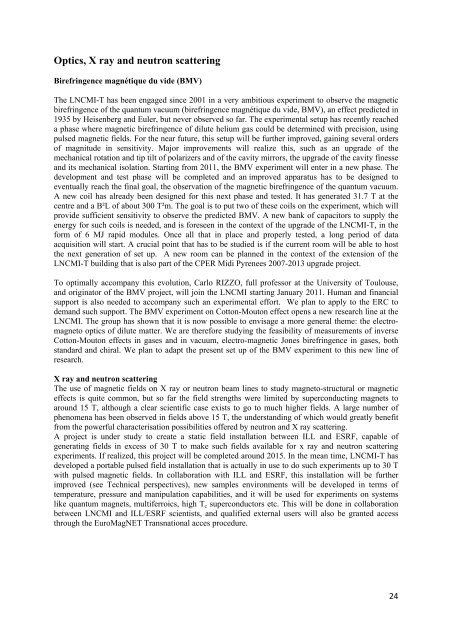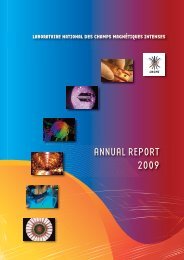Laboratoire National des Champs Magnétiques Pulsés CNRS – INSA
Laboratoire National des Champs Magnétiques Pulsés CNRS – INSA
Laboratoire National des Champs Magnétiques Pulsés CNRS – INSA
Create successful ePaper yourself
Turn your PDF publications into a flip-book with our unique Google optimized e-Paper software.
Optics, X ray and neutron scattering<br />
Birefringence magnétique du vide (BMV)<br />
The LNCMI-T has been engaged since 2001 in a very ambitious experiment to observe the magnetic<br />
birefringence of the quantum vacuum (birefringence magnétique du vide, BMV), an effect predicted in<br />
1935 by Heisenberg and Euler, but never observed so far. The experimental setup has recently reached<br />
a phase where magnetic birefringence of dilute helium gas could be determined with precision, using<br />
pulsed magnetic fields. For the near future, this setup will be further improved, gaining several orders<br />
of magnitude in sensitivity. Major improvements will realize this, such as an upgrade of the<br />
mechanical rotation and tip tilt of polarizers and of the cavity mirrors, the upgrade of the cavity finesse<br />
and its mechanical isolation. Starting from 2011, the BMV experiment will enter in a new phase. The<br />
development and test phase will be completed and an improved apparatus has to be <strong>des</strong>igned to<br />
eventually reach the final goal, the observation of the magnetic birefringence of the quantum vacuum.<br />
A new coil has already been <strong>des</strong>igned for this next phase and tested. It has generated 31.7 T at the<br />
centre and a B²L of about 300 T²m. The goal is to put two of these coils on the experiment, which will<br />
provide sufficient sensitivity to observe the predicted BMV. A new bank of capacitors to supply the<br />
energy for such coils is needed, and is foreseen in the context of the upgrade of the LNCMI-T, in the<br />
form of 6 MJ rapid modules. Once all that in place and properly tested, a long period of data<br />
acquisition will start. A crucial point that has to be studied is if the current room will be able to host<br />
the next generation of set up. A new room can be planned in the context of the extension of the<br />
LNCMI-T building that is also part of the CPER Midi Pyrenees 2007-2013 upgrade project.<br />
To optimally accompany this evolution, Carlo RIZZO, full professor at the University of Toulouse,<br />
and originator of the BMV project, will join the LNCMI starting January 2011. Human and financial<br />
support is also needed to accompany such an experimental effort. We plan to apply to the ERC to<br />
demand such support. The BMV experiment on Cotton-Mouton effect opens a new research line at the<br />
LNCMI. The group has shown that it is now possible to envisage a more general theme: the electromagneto<br />
optics of dilute matter. We are therefore studying the feasibility of measurements of inverse<br />
Cotton-Mouton effects in gases and in vacuum, electro-magnetic Jones birefringence in gases, both<br />
standard and chiral. We plan to adapt the present set up of the BMV experiment to this new line of<br />
research.<br />
X ray and neutron scattering<br />
The use of magnetic fields on X ray or neutron beam lines to study magneto-structural or magnetic<br />
effects is quite common, but so far the field strengths were limited by superconducting magnets to<br />
around 15 T, although a clear scientific case exists to go to much higher fields. A large number of<br />
phenomena has been observed in fields above 15 T, the understanding of which would greatly benefit<br />
from the powerful characterisation possibilities offered by neutron and X ray scattering.<br />
A project is under study to create a static field installation between ILL and ESRF, capable of<br />
generating fields in excess of 30 T to make such fields available for x ray and neutron scattering<br />
experiments. If realized, this project will be completed around 2015. In the mean time, LNCMI-T has<br />
developed a portable pulsed field installation that is actually in use to do such experiments up to 30 T<br />
with pulsed magnetic fields. In collaboration with ILL and ESRF, this installation will be further<br />
improved (see Technical perspectives), new samples environments will be developed in terms of<br />
temperature, pressure and manipulation capabilities, and it will be used for experiments on systems<br />
like quantum magnets, multiferroics, high Tc superconductors etc. This will be done in collaboration<br />
between LNCMI and ILL/ESRF scientists, and qualified external users will also be granted access<br />
through the EuroMagNET Transnational acces procedure.<br />
24







